The Minimally Invasive Laser Therapy Devices Market is estimated to be valued at USD 2.7 billion in 2025 and is projected to reach USD 5.9 billion by 2035, registering a compound annual growth rate (CAGR) of 8.1% over the forecast period.
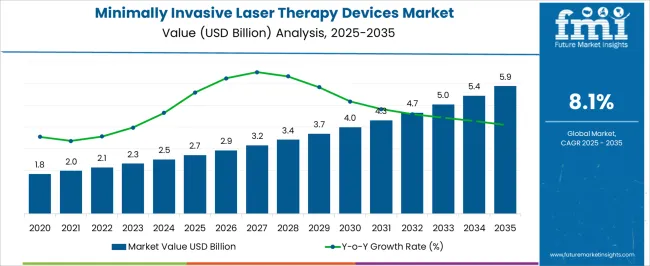
| Metric | Value |
|---|---|
| Minimally Invasive Laser Therapy Devices Market Estimated Value in (2025 E) | USD 2.7 billion |
| Minimally Invasive Laser Therapy Devices Market Forecast Value in (2035 F) | USD 5.9 billion |
| Forecast CAGR (2025 to 2035) | 8.1% |
The Minimally Invasive Laser Therapy Devices market is experiencing steady growth due to the increasing adoption of advanced therapeutic technologies that offer targeted treatment with minimal disruption to surrounding tissues. The market is being influenced by rising awareness of non-invasive and outpatient medical procedures that reduce recovery time and enhance patient comfort. The integration of precision laser technology in multiple therapeutic areas has enabled better treatment outcomes and improved procedural efficiency.
The demand for devices that can be customized for specific medical conditions has accelerated investment in research and development, supporting product innovation. Additionally, growing healthcare infrastructure and increasing prevalence of chronic and lifestyle-related conditions are driving the adoption of minimally invasive solutions globally.
The market outlook is further strengthened by the rising preference for portable and user-friendly devices that can be deployed across clinics, hospitals, and specialty care centers As the trend toward digital healthcare and minimally invasive procedures continues, the market is positioned to expand with the introduction of next-generation laser therapy solutions capable of combining efficiency, safety, and clinical effectiveness.
The minimally invasive laser therapy devices market is segmented by product type, modality, applications, end users, and geographic regions. By product type, minimally invasive laser therapy devices market is divided into Low level Minimally Invasive Laser Therapy Devices and High Level Minimally Invasive Laser Therapy Devices. In terms of modality, minimally invasive laser therapy devices market is classified into Portable Minimally Invasive Laser Therapy Devices and Stand-alone Minimally Invasive Laser Therapy Devices. Based on applications, minimally invasive laser therapy devices market is segmented into Dermatology, ENT, Oncology, Cosmetics, Dental, Gastroenterology and Endoscopy, Cardiovascular, and Others. By end users, minimally invasive laser therapy devices market is segmented into Hospitals, Clinics, Skin Care Service Centers, Ophthalmic Clinics, Dental Clinics, and Others. Regionally, the minimally invasive laser therapy devices industry is classified into North America, Latin America, Western Europe, Eastern Europe, Balkan & Baltic Countries, Russia & Belarus, Central Asia, East Asia, South Asia & Pacific, and the Middle East & Africa.
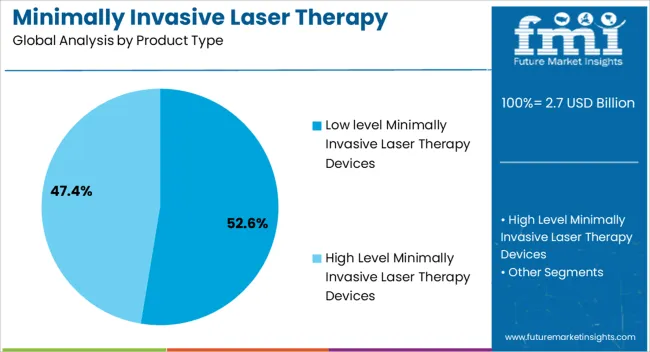
The Low level Minimally Invasive Laser Therapy Devices segment is projected to hold 52.60% of the overall product type revenue share in 2025, making it the leading segment. This dominance is being attributed to the non-thermal mechanism of low level lasers, which allows for pain relief, wound healing, and tissue regeneration without damaging surrounding structures. Adoption has been accelerated by the growing preference for non-invasive treatments in outpatient and rehabilitative care, as these devices minimize downtime and improve patient satisfaction.
The segment’s growth has also been supported by the relative affordability and portability of low level devices, which enables deployment in multiple clinical settings. Additionally, advancements in device miniaturization and user interface design have facilitated greater accessibility for practitioners and integration into routine clinical workflows.
The increased focus on physiotherapy, dermatology, and pain management has further reinforced this segment’s market share As healthcare providers continue to prioritize patient comfort, efficacy, and procedural flexibility, the low level minimally invasive laser devices segment is expected to maintain its leadership position.
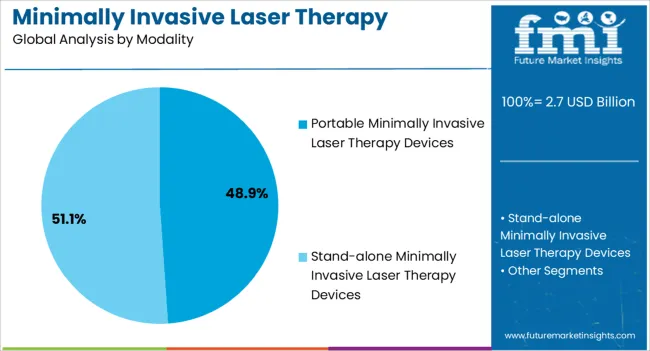
The Portable Minimally Invasive Laser Therapy Devices segment is expected to account for 48.90% of the modality revenue share in 2025, emerging as the largest segment in the modality classification. This growth is being driven by the demand for mobility, ease of use, and rapid deployment across multiple treatment environments. Portable devices allow healthcare providers to offer therapy at the point of care, including clinics, outpatient centers, and home healthcare, increasing accessibility for patients.
The flexibility to use these devices without requiring extensive infrastructure has enhanced adoption rates. The segment’s growth has also been supported by technological advances that improve battery life, precision, and safety features, making them suitable for repeated and consistent use.
Rising adoption in cosmetic and dermatology procedures, rehabilitation centers, and pain management clinics has further contributed to the segment’s prominence As healthcare continues to move toward patient-centered, decentralized care models, the demand for portable minimally invasive laser therapy devices is expected to expand steadily, reinforcing their leadership within the modality classification.
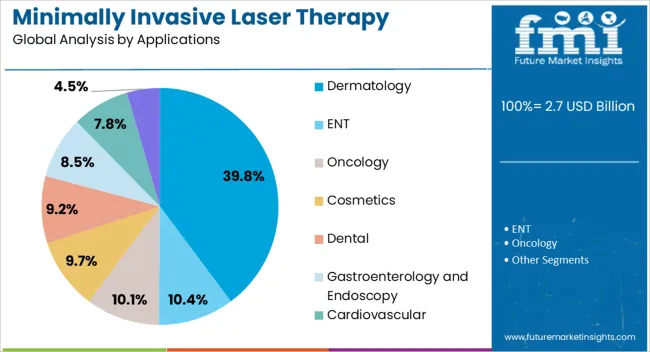
The Dermatology application segment is anticipated to capture 39.80% of the overall market revenue in 2025, positioning it as the leading application area for minimally invasive laser therapy devices. This segment’s growth is being influenced by the rising demand for non-invasive dermatological treatments for conditions such as acne, pigmentation, skin rejuvenation, and scar management. Adoption has been driven by patient preference for procedures that offer minimal discomfort, reduced recovery times, and visible results without surgical intervention.
Dermatology clinics and cosmetic centers are increasingly integrating laser-based solutions to differentiate services and meet growing consumer expectations. The segment’s prominence is further supported by the continuous development of advanced laser technologies that enhance precision, efficacy, and safety.
Additionally, the accessibility of these devices for outpatient procedures has made them highly suitable for high-volume clinical settings With growing awareness of aesthetic treatments and the increasing emphasis on minimally invasive therapies, the dermatology application segment is expected to continue leading the market, offering significant growth opportunities for device manufacturers and healthcare providers.
Laser therapy is a therapeutic treatment that utilizes concentrated light for medical procedures. In contrast to most light sources, light from a laser is tuned to particular wavelengths. Minimally invasive medical devices have changed surgical procedures by eliminating or shortening hospital stays, speeding recovery times, decreasing the size of incisions and improving overall patient outcomes. There is a consistent increase in the number of minimally invasive procedures. Minimally invasive laser therapy devices are used for various different applications in oncology, dermatology, ENT etc.
Minimally invasive laser therapy devices are highly preferred for neonatal patients and is also popular for cosmetic purposes as it least damages the skin. According to the annual plastic surgery procedural statistics, approximately 15.9 million minimally-invasive and surgical cosmetic procedures were performed in 2025 in the United States; giving a 2% increase over 2025.
Growing popularity of cosmetic procedures; increase in number of laser procedures; growing shift towards minimally invasive surgeries are three major factors that are expected to boost market growth for minimally invasive laser therapy devices during the forecast period. Increased prevalence of skin related disorders like actinic keratosis, warts, acnes and growing awareness on advantages of minimally invasive laser therapy devices over invasive therapy devices are also expected to contribute to the growth of minimally invasive laser therapy devices market during the forecast period.
Whereas, high prices associated to these procedures might hinder market growth. Less availability and less awareness on novel technologies related to minimally invasive laser therapy devices also could hamper the market growth for minimally invasive laser therapy devices market during the forecast period.
The technological shift of medical procedures and constant exponential development in technologies for medical procedures have profited the market. This has led to surgeries and procedures getting minimally invasive thus, requiring less healing time and imposing lower risk to practitioners and patients alike. Low level minimally invasive laser therapy devices are highly preferred due to less exposure of laser light to the body thus, having less side effects like swelling or redness. Minimally invasive laser therapy devices are highly being used for cosmetic purposes.
Number of plastic surgeries performed globally have increased drastically, contributing to the market growth for minimally invasive laser therapy devices. Growing number of healthcare facilities like cosmetic clinics and ophthalmic clinics owing it to increased government support and funding are also extensively contributing to the market growth.
Geography wise, Minimally Invasive Laser Therapy Devices market is divided into eight regions viz. North-America, Asia- Pacific excluding China & Japan, China, Japan, Western Europe, Eastern Europe, Latin America and Middle-East & Africa. North America's Minimally Invasive Laser Therapy Devices market is expanding because of growing popularity of minimally laser therapy devices and it will remain dominant over the period of forecast due to growing need of treating patients using minimally invasive techniques.
Rise in incidence of dermatology, eye and dental related ailments also contributes to the share in the region. Europe's Minimally Invasive Laser Therapy Devices market is also expected to grow at a significant rate due to increased healthcare expenditure and increased acceptance of these novel laser techniques. Asia-Pacific's Minimally Invasive Laser Therapy Devices market is anticipated to grow at a decent rate due to low availability of minimally invasive laser therapy devices.
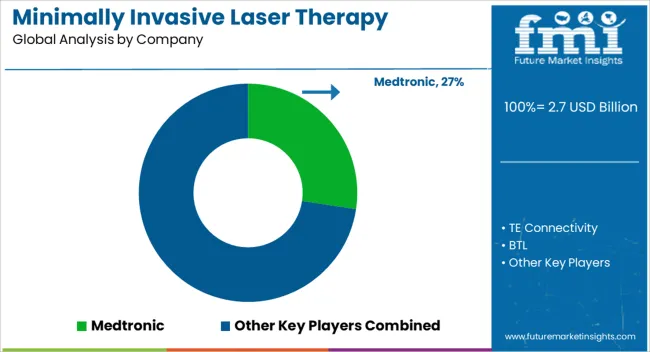
Some of the market participants in the Global Minimally Invasive Laser Therapy Devices market identified across the value chain include: TE Connectivity, BTL, Boston Scientific Corporation, Medtronic, Wytech Industries, Inc., Norwood Medical, Freudenberg Medical and Cynosure.
The research report presents a comprehensive assessment of the market and contains thoughtful insights, facts, historical data, and statistically supported and industry-validated market data. It also contains projections using a suitable set of assumptions and methodologies. The research report provides analysis and information according to market segments such as geographies, application, and industry.
The report is a compilation of first-hand information, qualitative and quantitative assessment by industry analysts, inputs from industry experts and industry participants across the value chain. The report provides in-depth analysis of parent market trends, macro-economic indicators and governing factors along with market attractiveness as per segments. The report also maps the qualitative impact of various market factors on market segments and geographies.
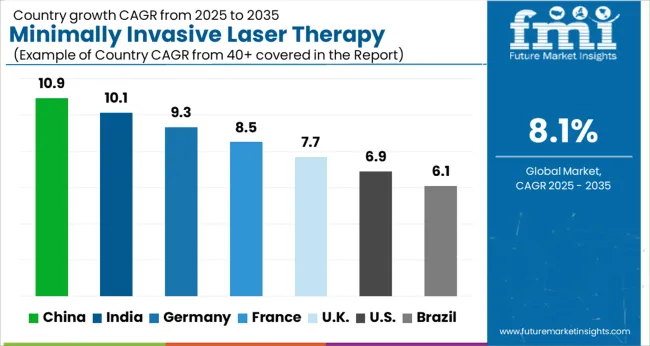
| Country | CAGR |
|---|---|
| China | 10.9% |
| India | 10.1% |
| Germany | 9.3% |
| France | 8.5% |
| UK | 7.7% |
| USA | 6.9% |
| Brazil | 6.1% |
The Minimally Invasive Laser Therapy Devices Market is expected to register a CAGR of 8.1% during the forecast period, exhibiting varied country level momentum. China leads with the highest CAGR of 10.9%, followed by India at 10.1%. Developed markets such as Germany, France, and the UK continue to expand steadily, while the USA is likely to grow at consistent rates. Brazil posts the lowest CAGR at 6.1%, yet still underscores a broadly positive trajectory for the global Minimally Invasive Laser Therapy Devices Market. In 2024, Germany held a dominant revenue in the Western Europe market and is expected to grow with a CAGR of 9.3%. The USA Minimally Invasive Laser Therapy Devices Market is estimated to be valued at USD 1.0 billion in 2025 and is anticipated to reach a valuation of USD 2.0 billion by 2035. Sales are projected to rise at a CAGR of 6.9% over the forecast period between 2025 and 2035. While Japan and South Korea markets are estimated to be valued at USD 133.6 million and USD 74.3 million respectively in 2025.
| Item | Value |
|---|---|
| Quantitative Units | USD 2.7 Billion |
| Product Type | Low level Minimally Invasive Laser Therapy Devices and High Level Minimally Invasive Laser Therapy Devices |
| Modality | Portable Minimally Invasive Laser Therapy Devices and Stand-alone Minimally Invasive Laser Therapy Devices |
| Applications | Dermatology, ENT, Oncology, Cosmetics, Dental, Gastroenterology and Endoscopy, Cardiovascular, and Others |
| End Users | Hospitals, Clinics, Skin Care Service Centers, Ophthalmic Clinics, Dental Clinics, and Others |
| Regions Covered | North America, Europe, Asia-Pacific, Latin America, Middle East & Africa |
| Country Covered | United States, Canada, Germany, France, United Kingdom, China, Japan, India, Brazil, South Africa |
| Key Companies Profiled | Medtronic, TE Connectivity, BTL, Boston Scientific, Wytech Industries, NOK Group, Cynosure, LiteCure, Biolitec, and Aspen Laser |
The global minimally invasive laser therapy devices market is estimated to be valued at USD 2.7 billion in 2025.
The market size for the minimally invasive laser therapy devices market is projected to reach USD 5.9 billion by 2035.
The minimally invasive laser therapy devices market is expected to grow at a 8.1% CAGR between 2025 and 2035.
The key product types in minimally invasive laser therapy devices market are low level minimally invasive laser therapy devices and high level minimally invasive laser therapy devices.
In terms of modality, portable minimally invasive laser therapy devices segment to command 48.9% share in the minimally invasive laser therapy devices market in 2025.






Our Research Products

The "Full Research Suite" delivers actionable market intel, deep dives on markets or technologies, so clients act faster, cut risk, and unlock growth.

The Leaderboard benchmarks and ranks top vendors, classifying them as Established Leaders, Leading Challengers, or Disruptors & Challengers.

Locates where complements amplify value and substitutes erode it, forecasting net impact by horizon

We deliver granular, decision-grade intel: market sizing, 5-year forecasts, pricing, adoption, usage, revenue, and operational KPIs—plus competitor tracking, regulation, and value chains—across 60 countries broadly.

Spot the shifts before they hit your P&L. We track inflection points, adoption curves, pricing moves, and ecosystem plays to show where demand is heading, why it is changing, and what to do next across high-growth markets and disruptive tech

Real-time reads of user behavior. We track shifting priorities, perceptions of today’s and next-gen services, and provider experience, then pace how fast tech moves from trial to adoption, blending buyer, consumer, and channel inputs with social signals (#WhySwitch, #UX).

Partner with our analyst team to build a custom report designed around your business priorities. From analysing market trends to assessing competitors or crafting bespoke datasets, we tailor insights to your needs.
Supplier Intelligence
Discovery & Profiling
Capacity & Footprint
Performance & Risk
Compliance & Governance
Commercial Readiness
Who Supplies Whom
Scorecards & Shortlists
Playbooks & Docs
Category Intelligence
Definition & Scope
Demand & Use Cases
Cost Drivers
Market Structure
Supply Chain Map
Trade & Policy
Operating Norms
Deliverables
Buyer Intelligence
Account Basics
Spend & Scope
Procurement Model
Vendor Requirements
Terms & Policies
Entry Strategy
Pain Points & Triggers
Outputs
Pricing Analysis
Benchmarks
Trends
Should-Cost
Indexation
Landed Cost
Commercial Terms
Deliverables
Brand Analysis
Positioning & Value Prop
Share & Presence
Customer Evidence
Go-to-Market
Digital & Reputation
Compliance & Trust
KPIs & Gaps
Outputs
Full Research Suite comprises of:
Market outlook & trends analysis
Interviews & case studies
Strategic recommendations
Vendor profiles & capabilities analysis
5-year forecasts
8 regions and 60+ country-level data splits
Market segment data splits
12 months of continuous data updates
DELIVERED AS:
PDF EXCEL ONLINE
Minimally Invasive Spine Technologies Market Size and Share Forecast Outlook 2025 to 2035
Minimally Invasive Deformity Correction System Market
The Minimally Invasive Neurosurgery Devices Market is segmented by device type, surgery type and end user from 2025 to 2035
Non-Invasive Blood Pressure Analyzer Market Size and Share Forecast Outlook 2025 to 2035
Non-Invasive Respiratory Monitoring Market Size and Share Forecast Outlook 2025 to 2035
Non-invasive Brain Stimulation System Market Size and Share Forecast Outlook 2025 to 2035
Non-invasive Pulse Wave Tonometer Market Size and Share Forecast Outlook 2025 to 2035
Non-invasive Surgical Wound Closure Market Analysis - Size, Share, and Forecast 2025 to 2035
Non-invasive Colon Cancer Screening Market
Non-Invasive Blood Glucose Monitoring Devices Market Size and Share Forecast Outlook 2025 to 2035
Helicobacter Pylori Non-Invasive Testing Market Size and Share Forecast Outlook 2025 to 2035
FBAR Devices Market
Snare devices Market
C-Arms Devices Market Size and Share Forecast Outlook 2025 to 2035
Timing Devices Market Analysis - Size, Growth, & Forecast Outlook 2025 to 2035
Spinal Devices Market Size and Share Forecast Outlook 2025 to 2035
Hearing Devices 3D Printing Market Size and Share Forecast Outlook 2025 to 2035
Medical Devices Market Size and Share Forecast Outlook 2025 to 2035
Network Devices Market Size and Share Forecast Outlook 2025 to 2035
Medical Devices Secondary Packaging Market Analysis by Material and Application Through 2035

Thank you!
You will receive an email from our Business Development Manager. Please be sure to check your SPAM/JUNK folder too.
Chat With
MaRIA